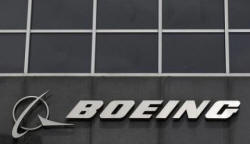|
 Design
flaws led to 2013 lithium-ion battery fire in Boeing 787: U.S. NTSB Design
flaws led to 2013 lithium-ion battery fire in Boeing 787: U.S. NTSB
 Send a link to a friend
Send a link to a friend
[December 02, 2014]
WASHINGTON (Reuters) - A lithium-ion
battery that caught fire aboard a parked Boeing 787 in 2013 in Boston
had design flaws and it should not have been certified by the U.S.
Federal Aviation Administration, U.S. accident investigators said on
Monday.
|
|
 The National Transportation Safety Board said the battery,
manufactured by GS Yuasa Corp, experienced an internal short circuit
that led to thermal runaway of the cell. This condition caused
flammable materials to be ejected outside the battery's case and
resulted in a small fire, the NTSB said in its report on the
incident. The National Transportation Safety Board said the battery,
manufactured by GS Yuasa Corp, experienced an internal short circuit
that led to thermal runaway of the cell. This condition caused
flammable materials to be ejected outside the battery's case and
resulted in a small fire, the NTSB said in its report on the
incident.
The agency said its investigators found a number of design and
manufacturing concerns that could have led to the short circuiting,
including the presence of foreign debris and an inspection process
that could not reliably detect defects.
"We are looking at the report from the NTSB, and until we have
examined its findings we don't wish to comment," a spokeswoman for
GS Yuasa said. The Japanese battery maker's shares dipped as much as
3.2 percent in Tokyo after the NTSB released its findings.
No one was hurt in the January 2013 incident aboard a Japan Airlines
plane. The fire broke out while the 787 Dreamliner was parked at
Boston's Logan Airport after passengers and crew had departed.
Boeing redesigned the battery and charger and designed a steel box
to contain fires and vent hot gasses outside the plane.
 "We consider the improvements made to the 787 battery system can
ensure safe operation as designed," a spokesman for Japan Airlines
said.
Another battery overheated on an All Nippon Airways plane later the
same month, prompting regulators to ground the global fleet until
April that year.
The Japan Transport Safety Board (JTSB), which investigated that
overheating, said in a report in September that engineers failed to
identify the possibility that a short circuit in one cell could
spread because they did not appropriately simulate the power unit's
on-board configuration. It also pointed to the possibility of cold
winter air damaging the battery cells and electrical wiring.
Boeing said it agreed with the NTSB's conclusion that a short
circuit led to the fire in Boston.
"We remain confident in the comprehensive improvements made to the
787 battery system following this event, and in the overall
performance of the battery system and the safety of the airplane,"
the company said in a statement.
[to top of second column] |

The batteries are widely used in cars, laptops and smartphones and
have a tendency to overheat through processes that are not well
understood by scientists.
Because the battery was a new technology, the FAA had required
Boeing to demonstrate its safety in aircraft.
The NTSB faulted Boeing for ruling out the possibility of thermal
runaway in its safety assessment of the battery, and it criticized
the FAA for certifying the battery without thoroughly scrutinizing
the potential danger.
The NTSB said it is recommending that the FAA improve the guidance
it provides to the aircraft industry and to FAA engineers on safety
assessments involving new technology.
"The FAA already has implemented many of the NTSB's recommendations
about modifications in testing, safety standards and design as part
of the 2013 certification of the 787's redesigned battery system,"
the FAA said in a statement on Monday.
(Reporting by Eric Beech; Additional reporting by Tim Kelly in
TOKYO; Editing by Mohammad Zargham, Jim Loney and Eric Walsh)
[© 2014 Thomson Reuters. All rights
reserved.] Copyright 2014 Reuters. All rights reserved. This material may not be published,
broadcast, rewritten or redistributed.

 |